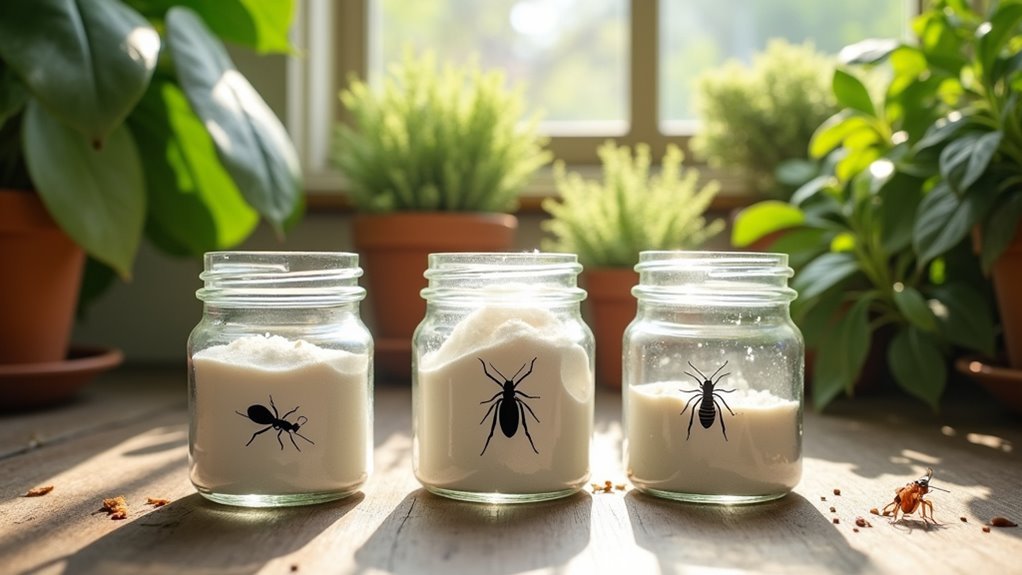You can safely eliminate household pests using three effective boric acid applications. Create sugar-mixed baits for ants and cockroaches that’ll poison entire colonies as the slow-acting formula spreads through their ranks. Apply disodium octaborate tetrahydrate solutions to wood surfaces for termite and wood-boring beetle control that lasts years. Use boric acid as a fungicide to prevent mold and mildew growth on wooden structures. These EPA-recognized, low-toxicity methods offer long-lasting protection for your home’s structural integrity and pest-free environment.
Ant and Cockroach Elimination With Boric Acid Baits

Two of the most persistent household pests, ants and cockroaches, meet their match with properly prepared boric acid baits. When these pests ingest boric acid, it acts as a stomach poison that disrupts their digestive systems.
You’ll find this pest control method particularly effective against pests because of its slow-acting nature. The poisoned ants and cockroaches return to their colonies before dying, spreading the toxin to others, including queens.
Mix boric acid with sugar or other attractants to create irresistible baits. Proper application in active pest areas greatly reduces populations over time. The residual effects last up to a year, providing ongoing pest control without frequent reapplication, making boric acid an efficient long-term solution.
Termite and Wood-Boring Beetle Control Using Borate Solutions
While boric acid baits effectively target mobile pests like ants and cockroaches, wood-destroying insects such as termites and wood-boring beetles require a different approach through borate solutions.
Disodium octaborate tetrahydrate provides environmentally friendly pest control by disrupting these pests’ digestive systems while preserving wood structures.
Disodium octaborate tetrahydrate delivers eco-friendly pest elimination by targeting insect digestive systems without compromising wooden structural elements.
You’ll benefit from borate compounds for effective pest control through:
- Versatile application methods – Apply as dusts or liquids in problem areas
- Low toxicity to humans – EPA-recognized safety for families and pets
- Long-lasting protection – Residual effects persist for several years
- Dual-action benefits – Eliminates pests while preventing fungal growth
These boric acid solutions offer superior protection against wood-destroying insects, making them ideal for preserving structural integrity.
Fungal Growth Prevention and Wood Preservation Applications

Beyond targeting destructive insects, boric acid excels as a powerful fungicide that protects wooden structures from mold, mildew, and decay.
You’ll find this compound particularly effective in wood preservation applications, where it creates a protective barrier against both fungal growth and insect infestations.
When you apply formulations like disodium octaborate tetrahydrate to wood surfaces, you’re extending the material’s lifespan considerably.
The compound’s low toxicity makes it safer for residential and commercial use compared to harsh chemical alternatives.
You can prevent moisture-related issues by maintaining regular applications, keeping wood dry and resistant to fungal problems.
These pest control properties guarantee your wooden structures maintain their integrity while avoiding costly structural damage from decay and deterioration.
Frequently Asked Questions
How Do You Mix Boric Acid for Pest Control?
You’ll mix one part boric acid with three parts sugar and one part water. Stir thoroughly until the boric acid completely dissolves. This creates an effective bait that attracts and kills cockroaches and ants.
What Bugs Does Boric Acid Get Rid Of?
You’ll eliminate cockroaches, ants, termites, silverfish, and various crawling insects with boric acid. It’s particularly effective against entire colonies since insects carry it back to nests, spreading the poison throughout their communities.
Is Boric Acid Safe to Use Around Pets?
Boric acid’s generally safe around pets when you use it properly, but you’ll need to prevent ingestion since it can cause vomiting and diarrhea. Keep products away from your pets always.
What Are 3 Uses for Boric Acid?
You can use boric acid as an insecticide to eliminate cockroaches and ants, as a fungicide to prevent mold growth, and as a wood preservative to protect against insects.
In Summary
You’ve now got three powerful, safe methods to tackle common pest problems around your home. Whether you’re dealing with ants and roaches, protecting against termites and wood borers, or preventing fungal damage, boric acid offers an effective, affordable solution. Remember to always follow safety guidelines when handling boric acid, keep it away from children and pets, and apply these treatments strategically for maximum effectiveness in your pest control efforts.





Leave a Reply